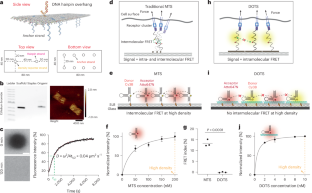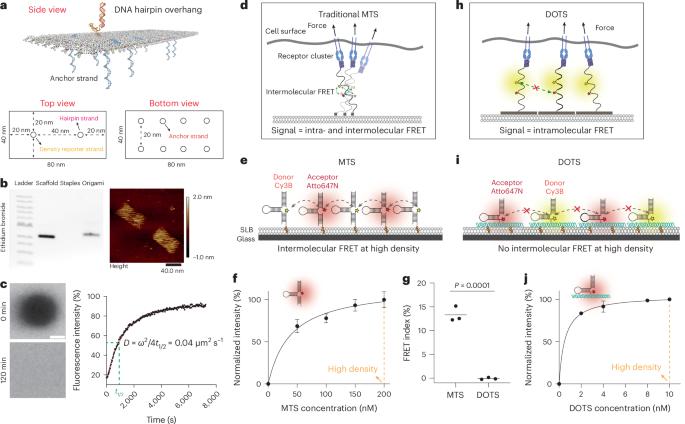Quantifying T cell receptor mechanics at membrane junctions using DNA origami tension sensors
IF 38.1
1区 材料科学
Q1 MATERIALS SCIENCE, MULTIDISCIPLINARY
引用次数: 0
Abstract
The T cell receptor (TCR) is thought to be a mechanosensor, meaning that it transmits mechanical force to its antigen and leverages the force to amplify the specificity and magnitude of TCR signalling. Although a variety of molecular probes have been proposed to quantify TCR mechanics, these probes are immobilized on hard substrates, and thus fail to reveal fluid TCR–antigen interactions in the physiological context of cell membranes. Here we developed DNA origami tension sensors (DOTS) which bear force sensors on a DNA origami breadboard and allow mapping of TCR mechanotransduction at dynamic intermembrane junctions. We quantified the mechanical forces at fluid TCR–antigen bonds and observed their dependence on cell state, antigen mobility, antigen potency, antigen height and F-actin activity. The programmability of DOTS allows us to tether these to microparticles to mechanically screen antigens in high throughput using flow cytometry. Additionally, DOTS were anchored onto live B cells, allowing quantification of TCR mechanics at immune cell–cell junctions. The authors present nanoscale DNA origami tension sensors tethered to lipid membranes and reveal the magnitude, dynamics and driving mechanisms of molecular forces experienced by immunoreceptors at fluid membrane junctions.


利用 DNA 折纸张力传感器量化膜连接处的 T 细胞受体力学结构
T细胞受体(TCR)被认为是一种机械传感器,这意味着它将机械力传递给其抗原,并利用这种力放大TCR信号的特异性和幅度。虽然已经提出了多种分子探针来量化 TCR 力学,但这些探针都固定在坚硬的基底上,因此无法揭示细胞膜生理环境下的流体 TCR 抗原相互作用。在这里,我们开发了DNA折纸张力传感器(DOTS),它在DNA折纸面包板上承载力传感器,可以绘制动态膜间连接处的TCR机械传导图。我们对流体 TCR 抗原结合处的机械力进行了量化,并观察了它们对细胞状态、抗原流动性、抗原效力、抗原高度和 F-肌动蛋白活性的依赖性。DOTS 的可编程性使我们能够将其拴在微颗粒上,利用流式细胞仪对抗原进行高通量机械筛选。此外,我们还将 DOTS 固定在活 B 细胞上,这样就能对免疫细胞-细胞连接处的 TCR 力学进行量化。
本文章由计算机程序翻译,如有差异,请以英文原文为准。
求助全文
约1分钟内获得全文
求助全文
来源期刊

Nature nanotechnology
工程技术-材料科学:综合
CiteScore
59.70
自引率
0.80%
发文量
196
审稿时长
4-8 weeks
期刊介绍:
Nature Nanotechnology is a prestigious journal that publishes high-quality papers in various areas of nanoscience and nanotechnology. The journal focuses on the design, characterization, and production of structures, devices, and systems that manipulate and control materials at atomic, molecular, and macromolecular scales. It encompasses both bottom-up and top-down approaches, as well as their combinations.
Furthermore, Nature Nanotechnology fosters the exchange of ideas among researchers from diverse disciplines such as chemistry, physics, material science, biomedical research, engineering, and more. It promotes collaboration at the forefront of this multidisciplinary field. The journal covers a wide range of topics, from fundamental research in physics, chemistry, and biology, including computational work and simulations, to the development of innovative devices and technologies for various industrial sectors such as information technology, medicine, manufacturing, high-performance materials, energy, and environmental technologies. It includes coverage of organic, inorganic, and hybrid materials.
 求助内容:
求助内容: 应助结果提醒方式:
应助结果提醒方式:


